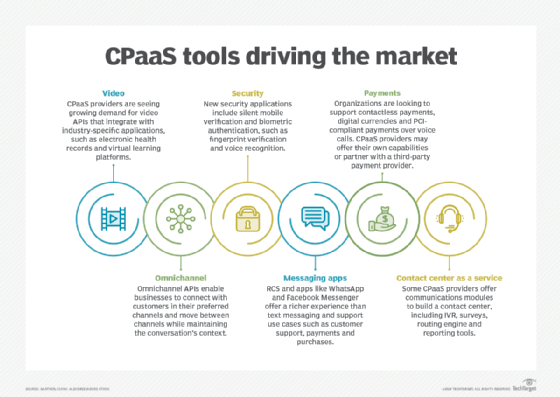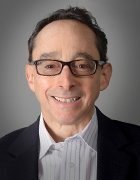What is communications platform as a service (CPaaS)?
Communications platform as a service is a cloud-based delivery model that lets organizations add real-time communications capabilities, such as voice, video and messaging, to business applications by deploying application programming interfaces.
APIs deliver communication capabilities such as Short Message Service (SMS), Multimedia Messaging Service, telephony and video. These services can be embedded into business applications like sales software to add notifications, click-to-call, multifactor authentication and other features.
Organizations that want to embed communications in their business applications use CPaaS. Cloud service providers and developers also use it to add communications capabilities to their applications and services.
The platforms include standards-based APIs, comprehensive SDKs and Java or .NET libraries for building applications on various platforms. CPaaS providers offer bundles of prepackaged, fully functional communication features that can be dropped into applications.
This article is part of
What is PaaS? Platform as a service definition and guide
Startups offering APIs for embedding communications, such as Plivo, TokBox (now Vonage) and Twilio, were the original drivers of CPaaS. Unified communications (UC) vendors, including Avaya Breeze, have entered the market with new services. Other vendors have entered the market by acquiring startups, as in the cases of Cisco acquiring Tropo and Vonage acquiring Nexmo.

How CPaaS works
CPaaS lets developers add real-time communications features to existing business applications. Rather than using applications explicitly created for communications, such as Microsoft Teams and Skype, CPaaS enables live chat, SMS, voice, video calling and other capabilities to be integrated into business applications. These features let organizations add services like video-enabled help desks, in-app messaging and authentication to their applications.
Third-party CPaaS services let in-house developers incorporate these features, using tools such as standards-based APIs, sample code and prebuilt applications. Some services might offer SDKs with libraries. As a cloud computing service, CPaaS communications features can be added to applications without companies investing in building their own back-end infrastructures.
CPaaS offers organizations a faster, lower-cost alternative to enabling communications in custom-built applications. It's typically billed monthly at a fixed rate for blocks of messages or minutes. Some CPaaS providers offer a pay-per-call, per-video or per-message billing model.
Early CPaaS deployments have focused on telehealth, field service, education, customer service, call center and social media applications.
Key CPaaS features
The most successful CPaaS platforms offer tools for embedding communication features directly into workflows. The most important features include the following:
- Voice APIs with call capabilities and interactive voice response systems.
- Messaging channels that support SMS and in-app messaging.
- Video integration that enables remote consultations and support.
- Authentication tools that allow secure interactions with one-time passwords through SMS or voice.
- Programmable notifications that automate alerts like payment reminders and escalations.
Benefits of CPaaS
The implementation of a CPaaS service has numerous benefits, including the following:
- In-house developers can customize application communications features according to their broader digital transformation strategy. This also provides control over the user experience and customer engagement.
- Existing business applications don't need to be replaced.
- Technical support for in-house developers includes online guides, forums for answers and live support.
- Developers can focus on building applications as opposed to underlying IT infrastructures.
- Cloud-hosted platforms allow for scalability.
- Infrastructure overhead and maintenance costs are lower.
- CPaaS services result in faster time to market for applications.
- Customers only pay for services used.
- Multi-tenancy is allowed within secure cloud environments.
CPaaS vs. unified communications as a service
Because CPaaS and UCaaS both focus on developing flexible, modern cloud communications systems and contain overlapping functionalities, they're easily confused. The primary difference is how providers deliver essential services to their clients.
UCaaS provides a ready-made platform where clients access different services, such as phone, video calling and call recording.
CPaaS is more of a "build your own" model with an open foundational platform that lets a client's in-house developer use ready-made APIs to build features. Vendors with more comprehensive offerings include sample code, modules, wrappers and SDKs for less experienced developers.

Types of CPaaS providers
CPaaS providers come from various backgrounds and business models. Gartner classifies vendors in the CPaaS market into five categories.
- Pure-play vendors. These are more established vendors in the CPaaS market, with service offerings beyond simpler SMS and voice APIs. These services support additional communication channels and feature extended APIs and modules. They also have more comprehensive sets of tools for developers. Vendors in this category include Infobip, MessageBird, Plivo, Sinch, Twilio and Vonage.
- Vendors specializing in SMS, application to person and person to application. A2P and P2A vendors have expanded into the CPaaS market. These vendors offer early-stage services or a consolidation of multiple disparate services. Vendors in this market segment include Kaleyra, Soprano Design, TeleSign and Zenvia.
- Traditional enterprise communications vendors. These vendors have integrated or augmented preexisting communications services, such as voice and video calling, into CPaaS products. Vendors in this segment include Alcatel-Lucent Enterprise, Avaya, Plum Voice and Ytel.
- Communications service providers. This category includes companies such as AT&T, which have unique competitive advantages, such as advanced network capabilities.
- Software providers for mobile applications. This category includes vendors such as Cisco's IMImobile and CM.com.
Choosing a CPaaS option
When selecting a CPaaS vendor, it's important to consider the following points:
- API quality and selection. Selection, depth and quality of APIs should be a primary consideration. Look for vendors with well-tested, reliable and stable APIs, and consider the programming languages the APIs support.
- Developer learning curve. Some CPaaS vendors will offer modules or wrappers that cater to developers with limited coding skills.
- Time in market. Smaller, younger CPaaS vendors are at risk of going under or getting acquired, which disrupts service.
- User and developer community. A healthy user community for the platform can help developers get the most out of the service's offerings.
- Network infrastructure strength. Look for vendors that can provide consistent and reliable service.
- Data security. Vendors must be able to ensure the security of data, rigorously monitoring the platform and applications.
CPaaS is a critical part of the customer experience. Explore the top CPaaS providers, trends and use cases.






